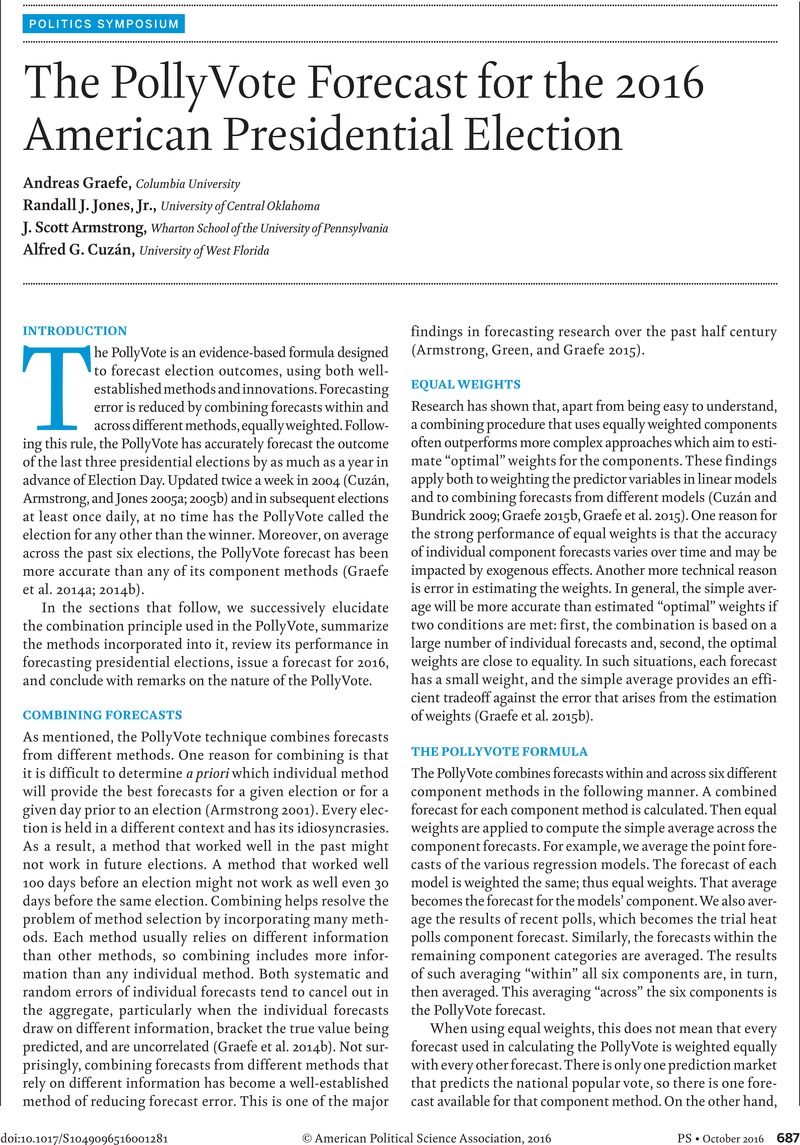No CrossRef data available.
Article contents
The PollyVote Forecast for the 2016 American Presidential Election
Published online by Cambridge University Press: 12 October 2016
Abstract
An abstract is not available for this content so a preview has been provided. Please use the Get access link above for information on how to access this content.

- Type
- Symposium: Forecasting the 2016 American National Elections
- Information
- PS: Political Science & Politics , Volume 49 , Special Issue 4: Elections in Focus , October 2016 , pp. 687 - 690
- Copyright
- Copyright © American Political Science Association 2016
References
REFERENCES
Armstrong, J. Scott. 2001. “Combining Forecasts.” In Principles of Forecasting: A Handbook for Researchers and Practitioners. Armstrong, J. Scott, Editor. New York: Springer, 417–39.Google Scholar
Armstrong, J. Scott and Cuzán, Alfred G.. 2006. “Index Methods for Forecasting: An Application to the American Presidential Elections.”
Foresight: International Journal of Applied Forecasting
3: 10–13.Google Scholar
Armstrong, J. Scott and Graefe, Andreas. 2011. “Predicting Elections from Biographical Information about Candidates: A Test of the Index Method.”
Journal of Business Research
64 (7): 699–706.Google Scholar
Armstrong, J. Scott, Green, Kesten C., and Graefe, Andreas. 2015. “Golden Rule of Forecasting: Be Conservative.”
Journal of Business Research
68 (8): 1717–31.Google Scholar
Campbell, James E. 2013
“Recap: Forecasting the 2012 Election,”
PS: Political Science & Politics
46 (1): 37.Google Scholar
Cuzán, Alfred G., Armstrong, J. Scott, and Jones, Randall J. Jr. 2005a. “How we Computed the PollyVote.”
Foresight: The International Journal of Applied Forecasting
1 (1): 51–2.Google Scholar
Cuzán, Alfred G., Armstrong, J. Scott, and Jones, Randall J. Jr.. 2005b. “The PollyVote: Applying the Combination Principle in Forecasting to the 2004 Presidential Election.” Paper presented at the 2005 International Symposium on Forecasting, San Antonio.Google Scholar
Cuzán, Alfred G. and Bundrick, Charles M.. 2009. “Predicting Presidential Elections with Equally Weighted Regressors in Fair’s Equation and the Fiscal Model.”
Political Analysis
17 (3): 333–40.Google Scholar
Franklin, Benjamin. 1956. “Benjamin Franklin’s 1772 letter to Joseph Priestley.” Available: http://www.procon.org/view.background-resource.php?resourceID=1474.Google Scholar
Graefe, Andreas. 2013. “Issue and Leader Voting in US Presidential Elections.”
Electoral Studies
32 (4): 644–57.Google Scholar
Graefe, Andreas. 2014. “Accuracy of Vote Expectation Surveys in Forecasting Elections.”
Public Opinion Quarterly
78 (S1): 204–32.Google Scholar
Graefe, Andreas. 2015a. “Accuracy Gains of Adding Vote Expectation Surveys to a Combined Forecast of US Presidential Election Outcomes.”
Research & Politics
2 (1): 1–5.Google Scholar
Graefe, Andreas. 2015b. “Improving Forecasts Using Equally Weighted Predictors.”
Journal of Business Research
68 (8): 1792–99.Google Scholar
Graefe, Andreas. 2016. “Political Markets.” Forthcoming (subject to changes) in the SAGE Handbook of Electoral Behavior. Available: https://www.researchgate.net/publication/292615991_Political_markets.Google Scholar
Graefe, Andreas, Armstrong, J. Scott, Jones, Randall J. Jr., and Cuzán, Alfred G.. 2014a. “Combining Forecasts: An Application to Elections.”
International Journal of Forecasting
30 (1): 43–54.CrossRefGoogle Scholar
Graefe, Andreas, Armstrong, J. Scott, Jones, Randall J. Jr., and Cuzán, Alfred G.. 2014b. “Accuracy of Combined Forecasts for the 2012 Presidential Elections: The PollyVote.”
PS: Political Science & Politics
47 (2): 427–31.Google Scholar
Graefe, Andreas, Armstrong, J. Scott, Jones, Randall J. Jr., and Cuzán, Alfred G.. 2009. “Combined Forecasts of the 2008 Election: The PollyVote.”
Foresight: The International Journal of Applied Forecasting
12: 41–42.Google Scholar
Graefe, Andreas, Küchenhoff, Helmut, Stierle, Veronika, and Riedl, Bernard. 2015. “Limitations of Ensemble Bayesian Model Averaging for Forecasting Social Science Problems,”
International Journal of Forecasting
31 (3): 943–951.Google Scholar
Jones, Randall J. Jr. 2008. “The State Of Presidential Election Forecasting: The 2004 Experience.”
International Journal of Forecasting
24 (2): 310–21.Google Scholar
Jones, Randall J. Jr. and Cuzán, Alfred G.. 2013. “Expert Judgment in Forecasting American Presidential Elections: A Preliminary Evaluation.” Presented at the 2013 meeting of the American Political Science Association, Chicago.Google Scholar
Lewis-Beck, Michael S. and Skalaban, Andrew. 1989. “Citizen Forecasting: Can Voters See into the Future?”
British Journal of Political Science
19 (1): 146–153.CrossRefGoogle Scholar
Lichtman, Alan J. 2005. “The Keys To The White House: An Index Forecast For 2008.”
International Journal of Forecasting
24 (2): 301–09.Google Scholar




